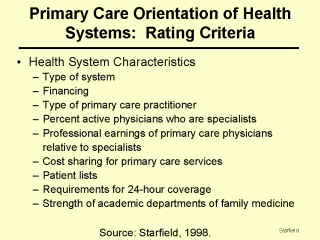| front |1 |2 |3 |4 |5 |6 |7 |8 |9 |10 |11 |12 |13 |14 |15 |16 |17 |18 |19 |20 |21 |22 |23 |24 |25 |26 |27 |28 |29 |30 |31 |32 |33 |34 |35 |36 |37 |38 |review |
 |
The predominant form of the
health system was rated according to the extent of its primary care orientation in two
regards: the strength of health policy conducive to primary care practice and the strength
of primary care practice itself. Health policy characteristics concerned to the extent to which there are efforts to distribute health services resources equitably in the population, the aegis and universality of financing for primary care, whether the modal primary care practitioner was a family physician, the balance between the number of primary care physicians and specialists as well as the amount of their professional remuneration, the absence of cost sharing for primary care services, requirements for the maintenance of patient rosters or lists, the extent of requirements for 24-hour coverage, and the strength of academic departments of family medicine. Each country was given a score of 0, 1, or 2 depending on how strongly the characteristic was developed. Source: Starfield B. Primary Care: Balancing Health Needs, Services, and Technology. New York: Oxford University Press, 1998. |